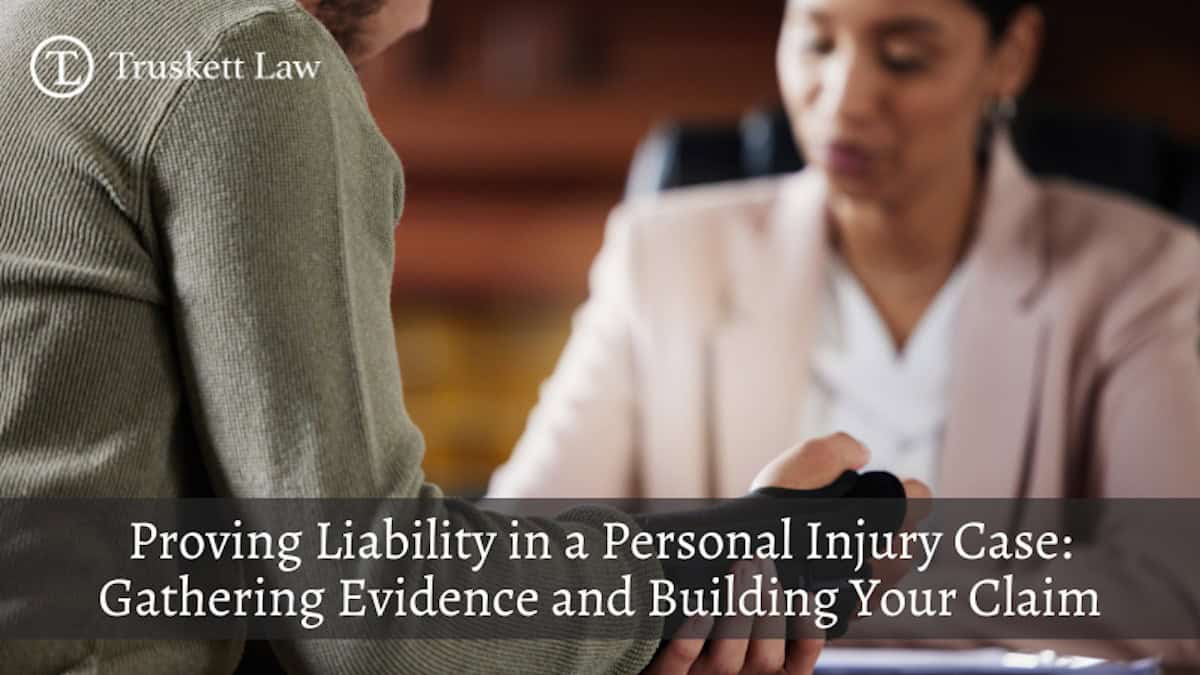
30 May Proving Liability in a Personal Injury Case: Gathering Evidence and Building Your Claim
Building Your Personal Injury Case Claim
Personal injury cases can be complex and challenging, often requiring substantial evidence to prove liability. Whether you are dealing with a car accident, slip and fall, medical malpractice, or any other type of injury, understanding how to gather evidence and build a strong claim is crucial. This guide will walk you through the essential steps and strategies for proving liability in a personal injury case.
Understanding Liability
Liability refers to the legal responsibility one party has for the damages suffered by another. In personal injury cases, proving liability means demonstrating that the defendant’s actions or negligence directly caused your injuries. To establish liability, you generally need to prove the following elements:
1. Duty of Care: The defendant had a legal obligation to act in a certain way toward the plaintiff.
2. Breach of Duty: The defendant breached that duty through action or inaction.
3. Causation: The breach of duty directly caused the plaintiff’s injury.
4. Damages: The plaintiff suffered actual harm or loss as a result.
Gathering Evidence
Evidence is the cornerstone of any personal injury claim. The more concrete and comprehensive your evidence, the stronger your case will be. Here are the primary types of evidence you should gather:

1. Physical Evidence
Physical evidence includes any tangible items that can support your claim. This might involve:
– Photographs and Videos: Take pictures and videos of the accident scene, your injuries, property damage, and any other relevant aspects. Visual evidence can be incredibly persuasive.
– Damaged Property: Preserve any property damaged in the incident, such as a wrecked vehicle or torn clothing. These items can serve as proof of the severity of the accident.
– Accident Scene Evidence: Collect evidence from the scene, such as skid marks, broken glass, or debris, which can help reconstruct the event.
2. Documentary Evidence
Documents are crucial in establishing the facts and supporting your narrative. Important documents include:
– Police Reports: Obtain a copy of the police report if law enforcement responded to the incident. Police reports often contain valuable details and observations.
– Medical Records: Keep detailed records of your medical treatment, including doctor’s notes, diagnostic tests, and bills. These records substantiate the extent of your injuries and the associated costs.
– Insurance Information: Gather information about the insurance policies involved, including your own and the defendant’s. This information is vital for negotiating settlements.
– Employment Records: If your injuries have impacted your ability to work, collect records that show lost wages and how your earning capacity has been affected.
3. Witness Testimonies
Witnesses can provide crucial first-hand accounts of the incident. To gather witness testimonies:
– Identify Witnesses: Identify anyone who saw the accident or has relevant information. This could include bystanders, passengers, or nearby residents.
– Obtain Statements: Ask witnesses to provide written or recorded statements detailing what they saw. Be sure to collect their contact information for future reference.
– Expert Witnesses: In some cases, expert witnesses such as accident reconstruction specialists, medical professionals, or vocational experts may be needed to provide professional opinions and analyses.
4. Electronic Evidence
In today’s digital age, electronic evidence can be invaluable. This includes:
– Surveillance Footage: Look for nearby security cameras that may have captured the incident. This footage can provide a clear and unbiased view of what happened.
– Electronic Data: In car accident cases, data from vehicle black boxes or mobile phone records can reveal critical information about the moments leading up to the accident.
– Social Media: Be cautious about your social media activity, but also consider whether the defendant’s social media posts might provide evidence of negligence or wrongdoing.
Building Your Personal Injury Case Claim
Once you have gathered the necessary evidence, the next step is to build a compelling claim. Here’s how to approach this process:
1. Organize Your Evidence
Keep all your evidence well-organized and easily accessible. Create a detailed file with sections for each type of evidence, and make copies to ensure nothing is lost. An organized presentation can make a significant difference in the clarity and strength of your case.

2. Establish the Facts
Clearly outline the facts of the case, based on the evidence you have gathered. Create a timeline of events leading up to, during, and after the incident. This timeline should be supported by your evidence and should logically demonstrate how the defendant’s actions led to your injuries.
3. Demonstrate Negligence
To prove negligence, you need to show that the defendant failed to meet their duty of care. This can be done by comparing their actions to what a reasonable person would have done in similar circumstances. Use your evidence to highlight specific instances where the defendant’s behavior fell short.
4. Show Causation
It’s not enough to show that the defendant was negligent; you must also prove that their negligence directly caused your injuries. Medical records, expert testimonies, and accident reconstruction reports can help establish this link.
5. Prove Damages
Demonstrating the extent of your damages is essential for securing fair compensation. This includes:
– Economic Damages: Document your medical expenses, lost wages, and any other financial losses. Keep receipts, bills, and financial statements to support your claims.
– Non-Economic Damages: Pain and suffering, emotional distress, and loss of enjoyment of life are also compensable. Detailed medical records and personal testimonies about how the injury has affected your life can help quantify these damages.
6. Negotiate or Litigate
With your evidence and arguments prepared, you can either negotiate a settlement with the defendant’s insurance company or proceed to litigation. During negotiations, present your case clearly and confidently, using your evidence to justify your demands. If a fair settlement cannot be reached, be prepared to take your case to court.
Working with a Personal Injury Case Attorney
Navigating a personal injury case on your own can be overwhelming. An experienced personal injury attorney can provide invaluable assistance by:
– Evaluating Your Case: An attorney can help you understand the strength of your case and the potential value of your claim.
– Gathering Evidence: Lawyers have the resources and expertise to gather and preserve evidence, including working with investigators and expert witnesses.
– Negotiating with Insurers: Insurance companies often aim to minimize payouts. An attorney can handle negotiations to ensure you receive fair compensation.
– Representing You in Court: If your case goes to trial, having a skilled attorney by your side can significantly improve your chances of success.
Conclusion
Proving liability in a personal injury case requires meticulous gathering and presentation of evidence. By understanding the key elements of liability and the types of evidence needed, you can build a strong claim. Organize your evidence, establish the facts, demonstrate negligence, show causation, and prove damages to make a compelling case for compensation. While it’s possible to handle a personal injury claim on your own, working with an experienced attorney can provide invaluable support and increase your chances of achieving a favorable outcome.
Remember, every personal injury case is unique. Tailor your approach to the specifics of your situation, and don’t hesitate to seek professional legal advice when needed. With the right evidence and strategy, you can hold the responsible party accountable and secure the compensation you deserve.


Sorry, the comment form is closed at this time.